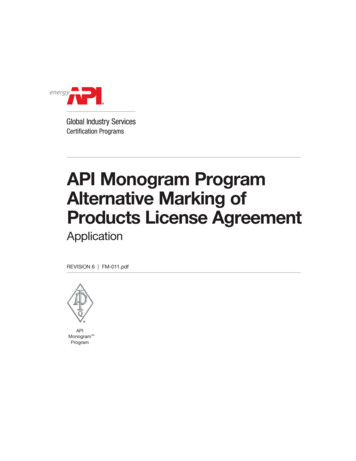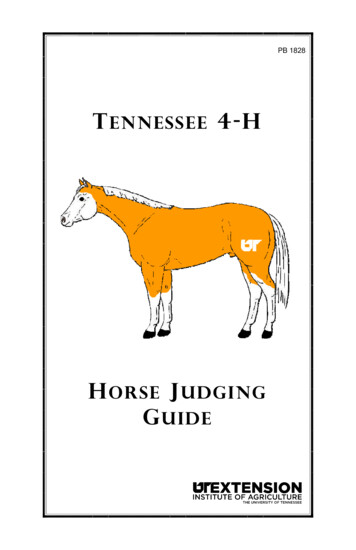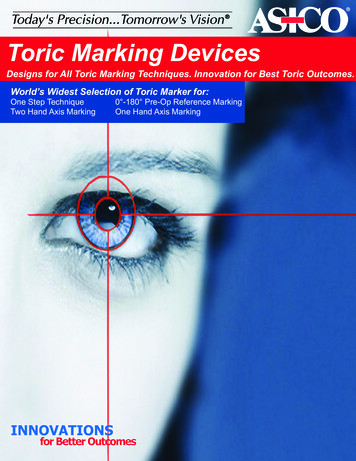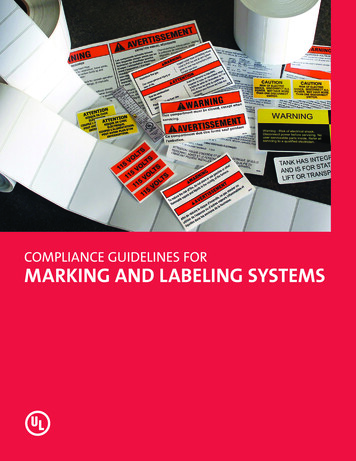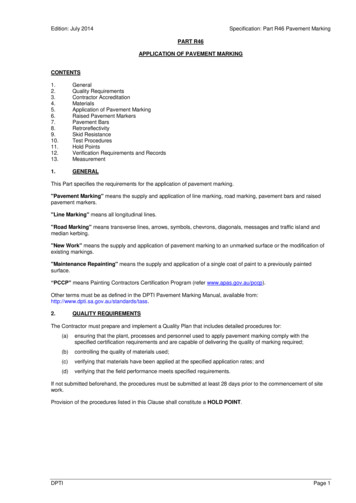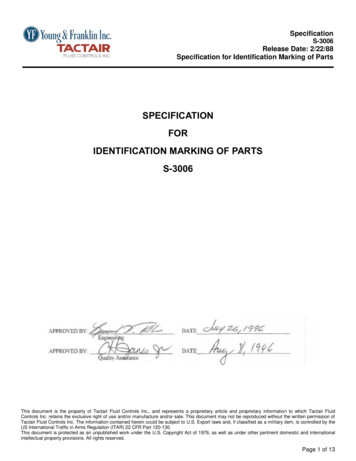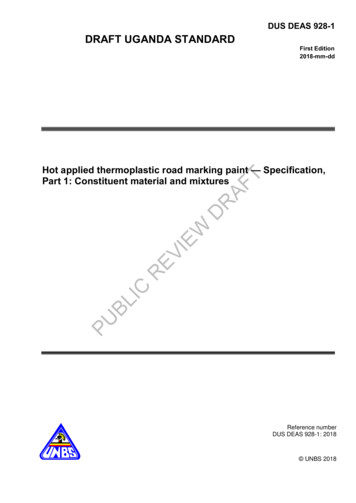
Transcription
White paperImplementation of direct part markingidentificationConsiderations for encoding, marking and verifyingautomotive and aerospace partsThe practice of Direct Part Mark Identification(DPMI) is used across many industries to identifyan array of end use items. This process, also referredto as machine-readable identification, is prevalentin the automotive and aerospace industries formarking alphanumeric and bar codes on individualparts and assemblies. This whitepaper will reviewthe code requirements, options for code applicationand verification considerations for DPMI.
ContentsIntroduction 3Encoding 4Marking 6Verifying 8The bottom line 92
IntroductionDPMI standards have been adopted by a numberof associations within the automotive andaerospace industries. Marking parts withmachine-readable codes allows for a part to betracked throughout the manufacturing processand the supply chain. Some manufacturers useDPMI to track high-value parts to deter theft orcounterfeiting; to pinpoint parts for service orrecalls; to determine liability, and to resolvewarranty issues.In parts production, the use of machinereadable codes can help reduce the need formanual code entry, increasing code accuracyand speeding-up data exchange. Electronicallygenerated codes that include both 1D and 2Dbar codes offer simple data storage and usagefor internal IT systems. For over 20 years, the 1Dbar code has been widely used for data delivery,but this format is being replaced in manyautomotive and aerospace production processeswith 2D formats. This is because 2D codes areable to contain more information in less spaceand can be applied with a variety of directmarking methods.The three main elements in DPMI are encoding,marking and verifying. Encoding is the renderingof a string of data into a pattern of dark andlight cells that includes data, padding and errorcorrection bytes to then be used by the markingdevice. Marking is the imprinting of contentdirectly on your part with the appropriatetechnology for the substrate. Verification is theact of confirming code accuracy and quality. Thisis most commonly performed immediatelyfollowing product imprinting at the markingstation.Example of a DPMI codeData encodedPart numberVideojet 123456780000000000000XSerial number987654321 YYDDDFull life cycle traceabilityDateManufacturerData Universal Numbering System(DUNS)Component codeSub-assembly codeFinal assembly codeSystem code3
EncodingData amount, type and quality for DataMatrix codesThe data type and amount to be encodeddetermines the DataMatrix size. A DataMatrixcode is a 2D matrix bar code consisting of blackand white modules arranged in either a square orrectangular pattern. A single symbol can store upto 3,116 numeric or 2,335 alphanumericcharacters. DataMatrix ECC 200 is currently thestandard in the automotive and aerospaceindustries.GS1 DataMatrix symbology has multiple sizes tomatch various data content. GS1 DataMatrixsymbology has 24 sizes of the square format rangingfrom 10 by 10 modules up to 144 by 144 modules,not including the 1-X surrounding Quiet Zone. Therectangular format has 6 sizes, ranging from 8 by 18modules up to 16 by 48 modules, not including the1-X surrounding Quiet Zone.GS1 – Global Standards One – is the internationalbody that governs standards for bar codingapplications. GS1 DataMatrix codes may beprinted in a square or rectangular format. Thesquare format is usually used as it has a largerrange of sizes and is the only format available forsymbols encoding a large amount of data. Thelargest rectangular symbol can encode 98 digits,while the largest square symbol can encode 3,116digits.Symbol 4 120 132 104 120 132 144Numeric61016243644607288124 172 228 288 348 408 560 736 912 1152 1392 1632 2100 2608 3116Alphanumeric361016253143526491127 169 214 259 304 418 550 682 862 1042 1222 1573 1954 2335Byte1361016202834426084Data Capacity112 142 172 202 278 366 454 574 694 814 1048 1302 1556Data capacity of square DataMatrix in relation to symbol size (number of dots in rows and columns) and data type usedSymbol 446498Alphanumeric61322314672Byte3814203047Data CapacityData capacity of rectangular DataMatrix in relation to symbol size(number of dots in rows and columns) and data type used4Example of a rectangularDataMatrix codeExample of a squareDataMatrix code
Quality of codes createdFor DataMatrix codes to be readable and reliable there are otherconsiderations outside of the basics of code creation. The shape of the dotsinside a DataMatrix code can be either round or square. Methods such asdot peening and inkjet produce round dots, and according to standards forthe codes, these dots should not be more than 105% larger or less than 60%smaller than the ideal dot size. If the dots are too big, they can touch oroverlap each other and become one large dot, making the code unreadable.If the dots are too small, there will be too much white space in betweenthem, providing insufficient printing for a reliable code. There are alsothreshold values established for deviations from the ideal circle to ensure theround dots produced will deliver a code that can be read reliably.Data is stored in a DataMatrix code according to a particularpattern. Each dot represents one bit. The dark dots are interpreted as“1” and the light dots as “0”. Eight bits together make up one byteand are referred to as a “code word,” which must contain a minimumof one alphanumeric and two numeric characters.Depiction of how data is distributed in a DataMatrix code. The eight bits of each byte aredisplayed in the same colour. The solid “L” shape on the outside is the alignment pattern. Theother two sides of the finder pattern are alternating light and dark elements. The rest of thecode contains bytes of data, padding, error correction, finder and timing, and unused cells.For ECC 200 codes, user data is encoded with the Reed-Solomonerror correction algorithm. With this algorithm, required data contentis accompanied by redundant data. If data is destroyed, theredundant data makes it possible to calculate the lost data. Up to62% of the code can be destroyed or contaminated, depending onsymbol size, and calculation is still possible. The additional dataplaced in the code helps ensure high security, but the required spaceis still very limited. Data redundancy in DataMatrix codes helpsensure high levels of readability and integrity.The position of the dots inside the matrix is essential for code reliability. Thedots should not deviate from the reference grid, or the ideal dot position(dot centre), either vertically or horizontally. In addition, the code should notbe distorted. The ideal angle between the X and Y axis is 90 , but a deviationof 7 is tolerable, according to current code standards.Correct dot sizeand shapeCorrect dot positionDot size too largeHorizontallymisaligned dotDot size too smallVerticallymisaligned dotIt may only be possible to produce round dots,depending on the marking method chosen.There are parameters set for deviations fromthe ideal circle shape to ensure the code canbe read. The difference between “D” and “d”should not be more than 20% of the dot size.Distortion of the code can occur duringmarking or reading, and every effort should bemade to avoid it. The ideal angle between theX and Y axes should be 90 . A deviation of 7 isallowable.Elongated dotDdCode distortion7ºxy5
MarkingThe optimal marking method depends on your part’ssubstrate and code requirementsAside from selecting code formatting and content,it is also important to consider the best method formarking the part. For the automotive andaerospace industries, the most common methodsare laser marking, continuous inkjet printing, dotpeening and electrochemical etching.UV laser uses ultraviolet light to produce ‘cold’marking that is safe and has damage-free printcapability on many substrates. UV lasers areideal for direct marking of permanent,high-grade codes to help prevent the risk ofcounterfeiting or for product traceability.CO2 laser coders use infrared laser light generatedvia radio frequency discharge in a carbon dioxidegas mixture. These laser systems code thermally bychanging the surface colour melting, foaming orremoving the material surface to create the code.With Continuous Inkjet (CIJ) technology, astream of ink enters a nozzle in the printhead,and an ultrasonic signal breaks the stream intotiny drops. These drops separate from the streamand receive a charge that determines theirvertical flight to form the characters printed onthe product.In dot peen marking, an indenting pin is used tocreate an indentation for each dot in theDataMatrix code.Electrochemical etching removes layers ofmaterial via electrolysis. This chemical etchingprocess takes an image on a stencil and transfersit to an electrically conductive product by theaction of electrolyte and electricity.Common marking options comparisonLaserContinuousInkjetDot nt on difficult surfaces, distance between partand marking deviceHighAverageAverageLowInvestment/initial ctNon-contactWith contactWith contactHighLowHighHighEase of moving marking equipment to otherlocations on the production lineLowHighHighHighThermal or chemical stressYesNoNoYesMaterials that can be markedVariety of substratesFlexibilityEase of integrationEase of communicating with PLC in production celland space needed for installation andmaintenanceType of marking methodNon-contact (part is not touched by markingapparatus)Contact (part is touched by marking apparatus)Abrasion resistance of markMobility6
Considerations for type of substrate and product code requirements affect the selection of the best marking method. The table below outlines the typesof substrates that are best-suited for each of the technology types.SyntheticsCO2 luminiumPrinting technology and substrate suitability Solid state laser UV laser Continuous inkjet Dot peening Electrochemical etching LaserDataMatrix codeprinted withCIJ technologyDataMatrix codeprinted withlaser technology Talk to yourcoding partnerexpert for helpselecting theright solutionfor yourmarkingapplication.DataMatrix codeprinted withdot peen technology7
VerifyingConfirmation of 2D code qualityand content accuracyVerification of 2D codes helps producers gauge the performance of the DPMI equipment in use. Verification systems can instantly provide alerts if thecodes produced do not pass verification, so any issues with the equipment can be addressed and corrected. Verification systems typically include a fixedcamera, optics, lighting, part fixtures and some kind of verification software. DPMI verification systems should be tailored to the application, providingspecific feedback required by individual users. When selecting a verification system, users need to know what the equipment is checking and exactly how theverification data is being used to help comply with code specification.Depending on the standard, the following criteria are used to evaluate DataMatrix codes:EvaluationcriteriaDescriptionGradeUse in accordance ks whether or not a code isA. (4.0)generally readable. An ‘A’ means easily F (0.0)readable, an ‘F’ means unreadable.PassesFailsChecks the contrast between thebright and dark dots in the code.A (4.0)B (3.0)C (2.0)D (1.0)F (0.0)SC 70%SC 55%SC 40%SC 20%SC 20%Axialnon-uniformityChecks the ratio between length andwidth of a code. If the code isstretched or compressed, it is given apoor rating for axial non-linearity.A (4.0)B (3.0)C (2.0)D (1.0)F (0.0)AN 0.06AN 0.08AN 0.10AN 0.12AN 0.12Unused errorcorrectionChecks how much redundant datahad to be used during reading todecode the data content.A (4.0)B (3.0)C (2.0)D (1.0)F (0.0)UEC 0.62UEC 0.50UEC 0.37UEC 0.25UEC 0.25Dot centreoffsetHorizontally misaligned dotChecks the extent to which dotcentres deviate from the theoreticalcentre.0% . 20%Dot size too largeChecks the degree of dot fill.60% . 105%Overall symbolgrade8 CC 30%CC 25%CC 20%CC 15%CC 15%(cell contrast)SC 20% Dot size too smallSummarizes the criteria. The poorestout of all the criteria used is alwaysoutput.A (4.0)B (3.0)C (2.0)D (1.0)F (0.0)AIM DPM Vertically misaligned dotCell sizeEN 9132
Each specific application will define not only codeparameters, but also print quality andspecifications for data formats, identifiers, andtransfer structures. The same is true with a DPMIverification system.When selecting a DPMI verification system, itshould not only be able to provide feedback on itsset-up, but it should also be able to log, report, andshare results as well as images and verificationdata. Additionally, the system should track, recordand score quality metrics for each part verified,providing time and date stamps as well as bitmapimages. Metrics should be based on internationalstandards such as ANSI and GS1.Optimised DPMI solutions will feature anoperator-friendly interface that allows users toenter set-up information. Common set-upinformation includes user name, lightingparameters, as well as camera-specific details suchas exposure values and optical settings.Example of a vision system verifying a DataMatrix code quality and data accuracyThe bottom line:Direct part marking is essential to full cycle traceability throughout themanufacturing process and supply chain.From basic 1D to 2D to DataMatrix codes, the success of your product marking and verification is dependent on the DPMI systemthat you select.At Videojet, we understand the complexity of direct part marking as well as the nuances of lean manufacturing. Capitalizing onour expertise, many automotive and aerospace OEM’s and part suppliers already trust Videojet. They utilise our global teamof experienced service engineers and coding specialists to help design and integrate coding solutions based on their uniqueapplication needs. Combined with a wide range of marking technologies for nearly every application, we can help you specifythe ideal coding solution for your production environment and help drive superior uptime in your operation.Trust the expertise of a global leader in product coding. Trust Videojet.9
Peace of mind comes as standardVideojet Technologies is a world-leader in the product identificationmarket, providing in-line printing, coding, and marking products,application specific fluids, and product life cycle services. ur goal is to partner with our customers in the consumerOpackaged goods, pharmaceutical, and industrial goodsindustries to improve their productivity, to protect andgrow their brands, and to stay ahead of industry trendsand regulations. With our customer application experts andtechnology leadership in Continuous Inkjet (CIJ), ThermalInkjet (TIJ), Laser Marking, Thermal Transfer Overprinting(TTO), case coding and labelling, and wide array printing,Videojet has more than 345,000 printers installed worldwide.Our customers rely on Videojet products to print on over tenbillion products daily. Customer sales, application, service andtraining support is provided by direct operations with over4,000 team members in 26 countries worldwide.In addition, Videojet’s distribution network includes morethan 400 distributors and OEMs, serving 135 countries.Global HeadquartersVideojet Sales & Service OfficesManufacturing & ProductDevelopmentCountries with VideojetSales & ServiceCountries with VideojetPartner Sales & ServiceCall us free on 0800 500 3023Email uksales@videojet.comor visit www.videojet.co.ukVideojet Technologies Ltd.4 & 5 Ermine Centre, Lancaster Way,Huntingdon, Cambridgeshire PE29 6XX / UK 2018 Videojet Technologies Inc. — All rights reserved.Videojet Technologies Inc.’s policy is one of continued product improvement.We reserve the right to alter design and/or specifications without notice.
Implementation of direct part marking identification Considerations for encoding, marking and verifying automotive and aerospace parts . verification data is being used to help comply with code specification. Depending on the standard, the following criteria are used to evaluate DataMatrix codes: Evaluation criteria Description Grade Use in .
